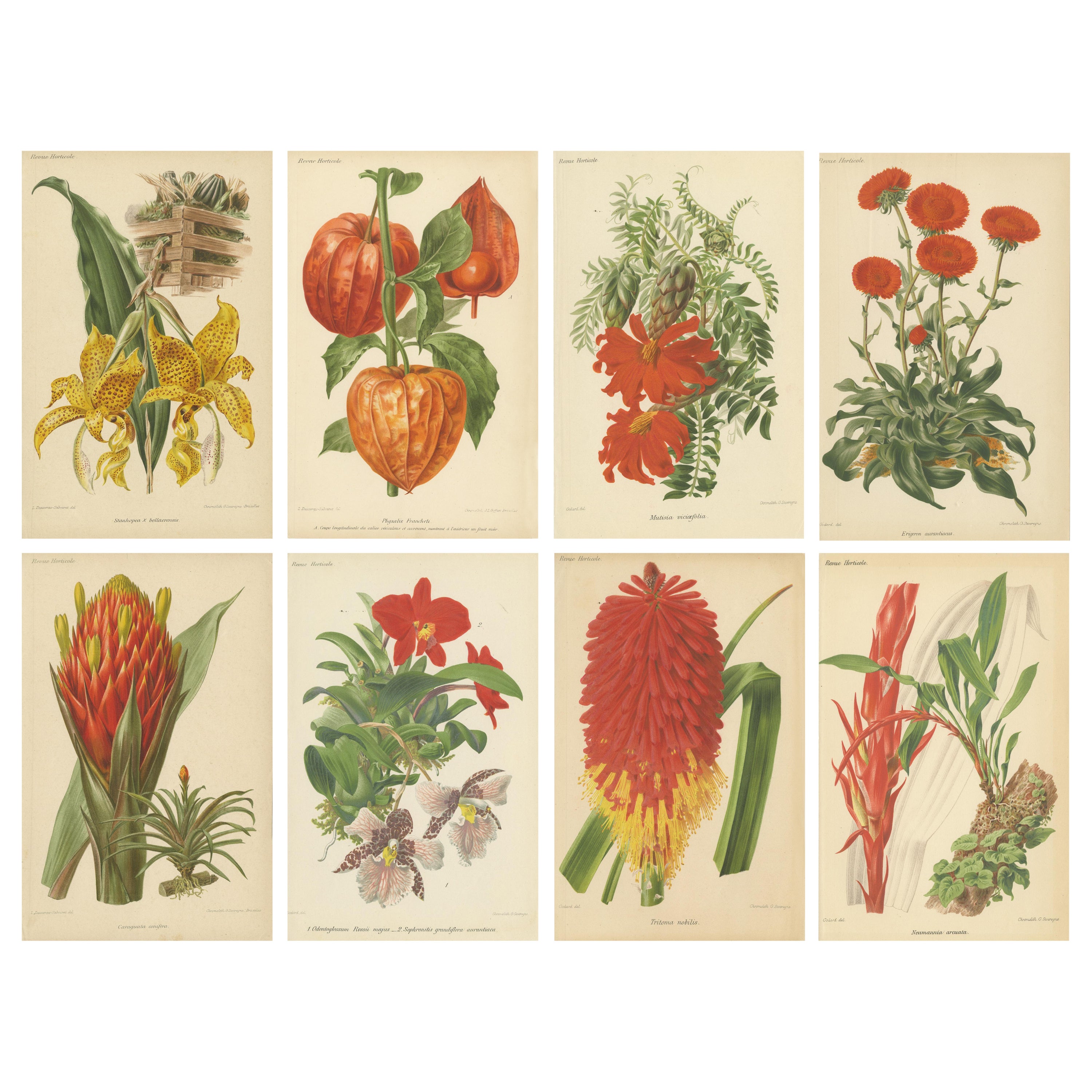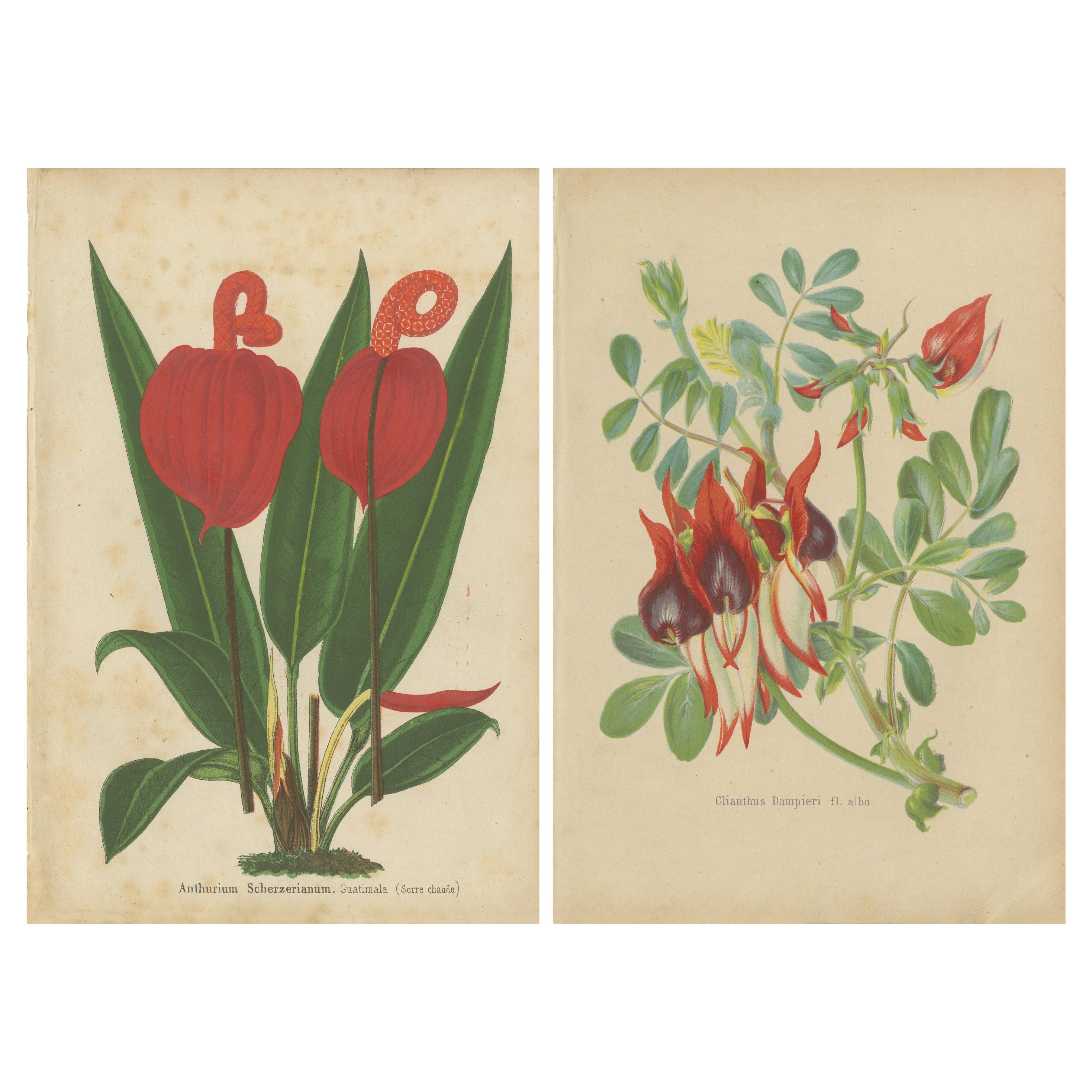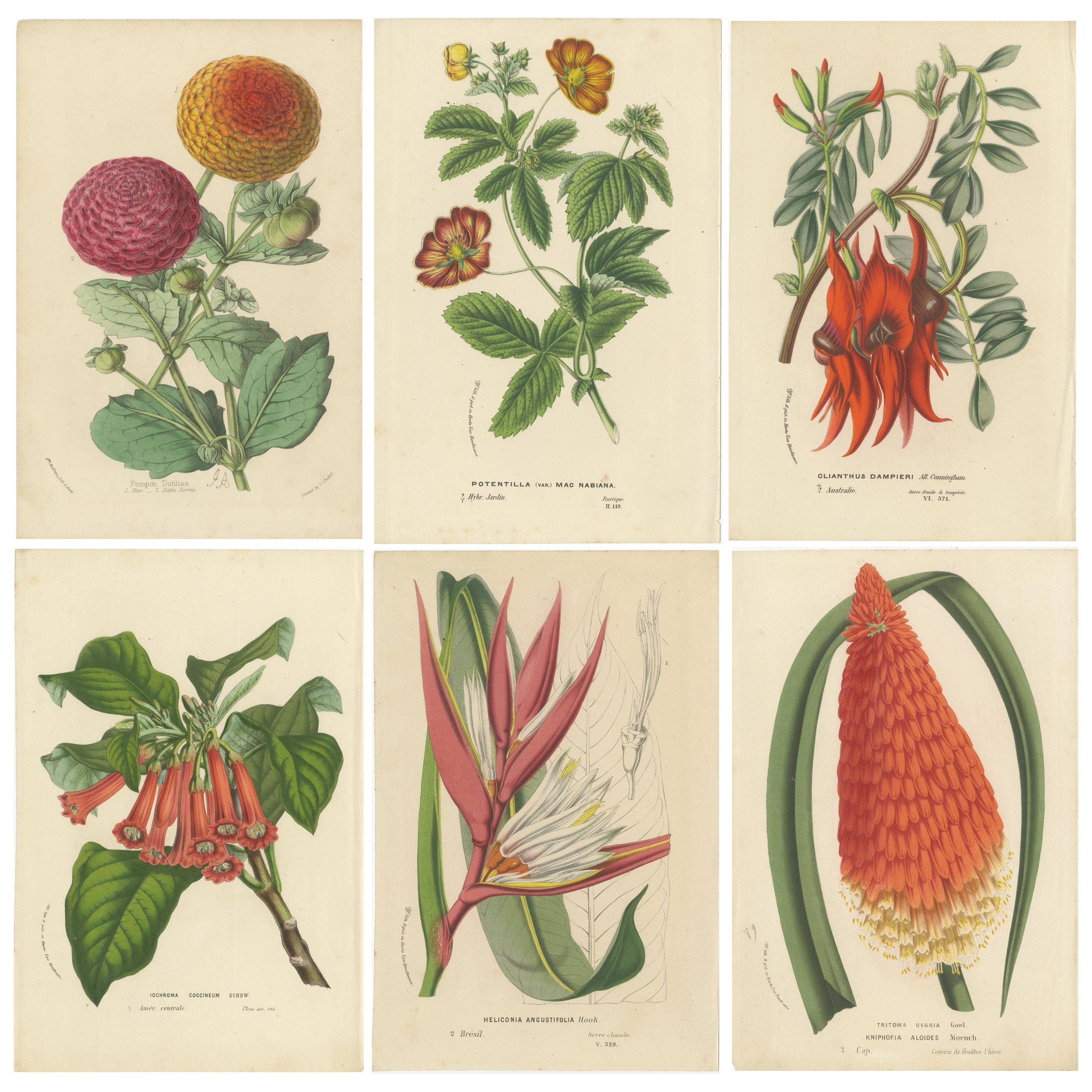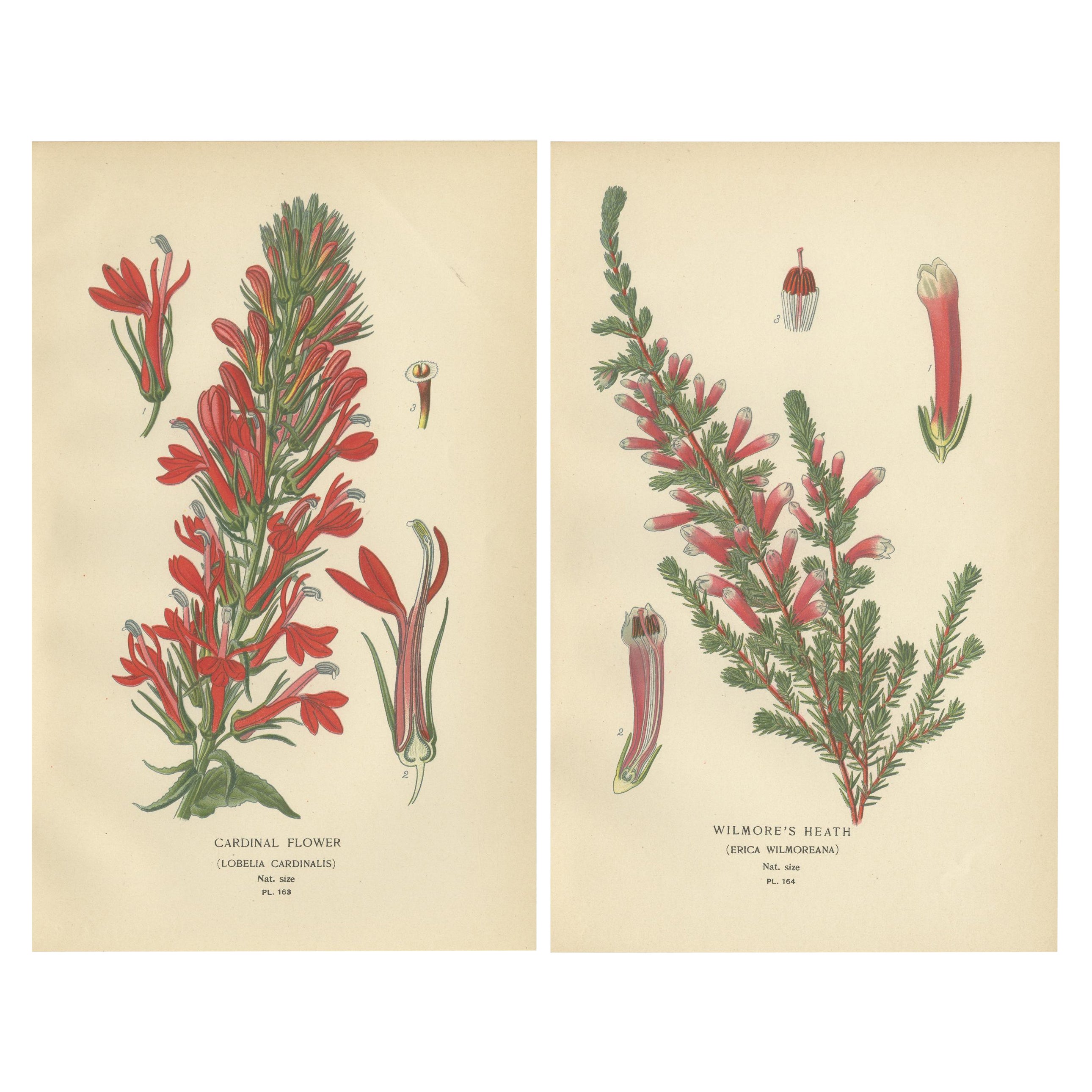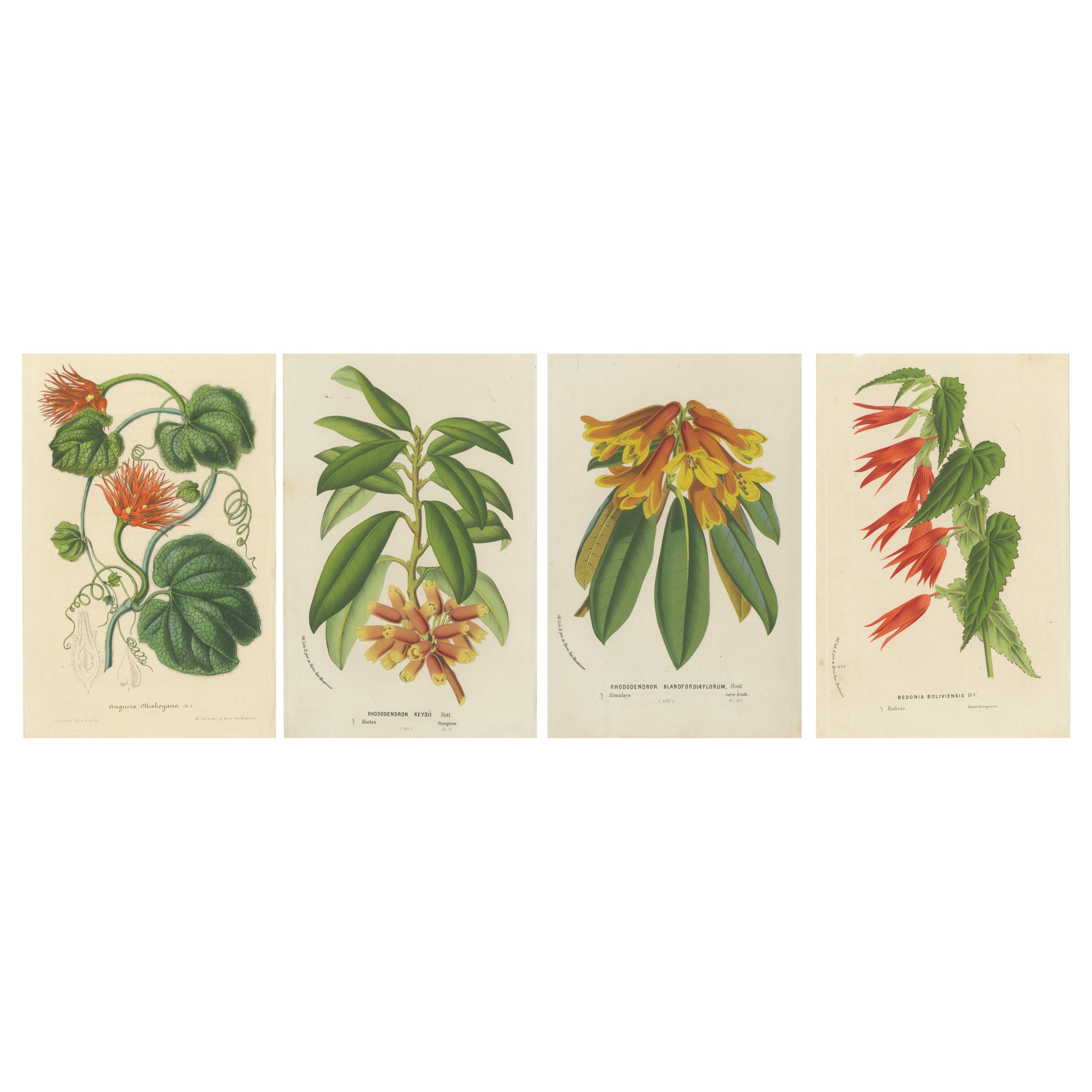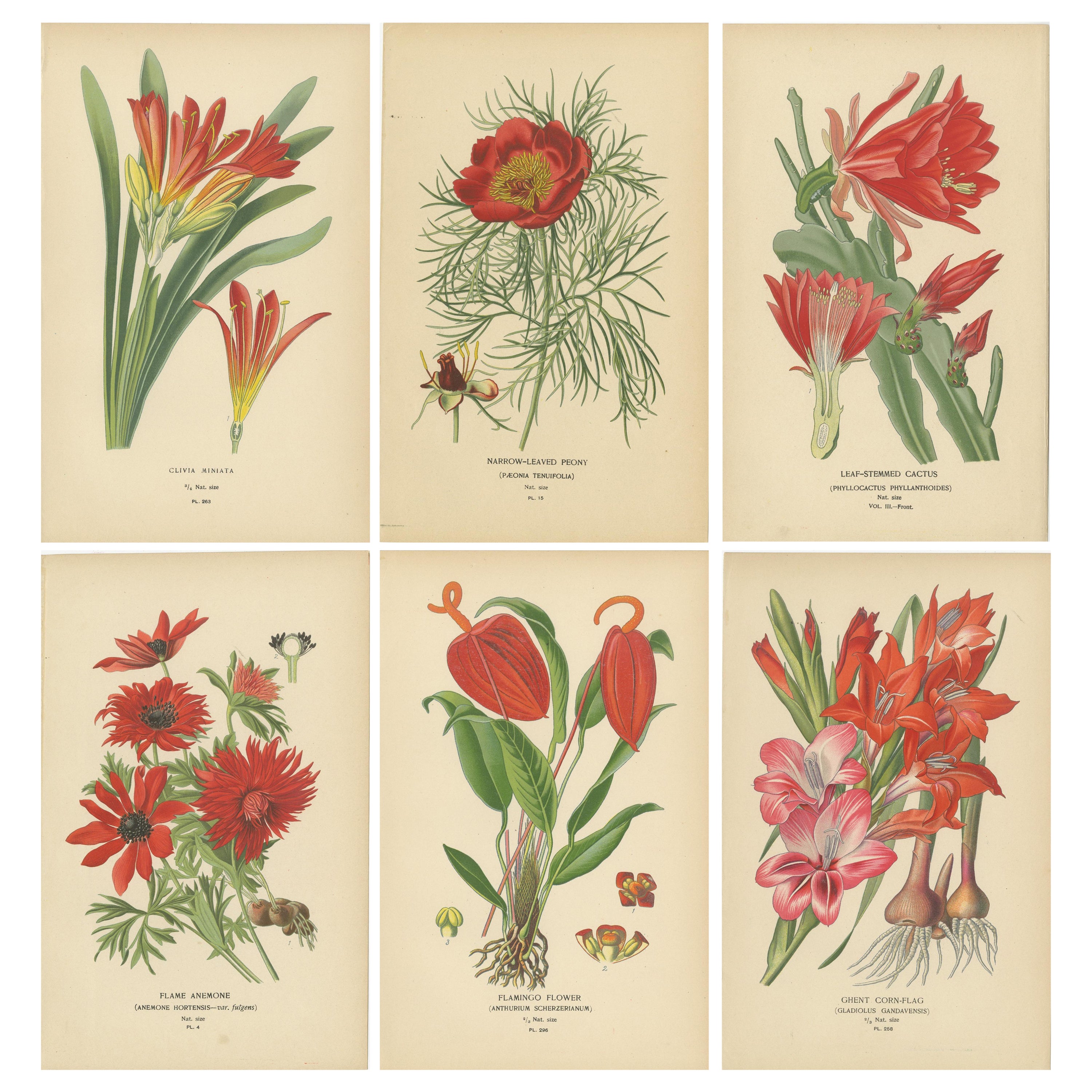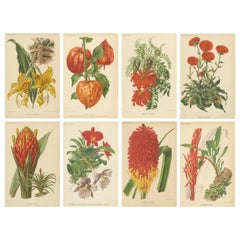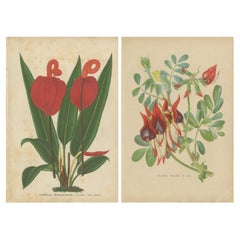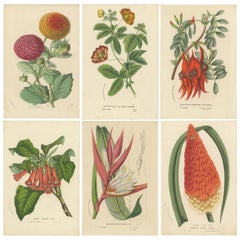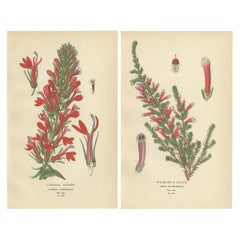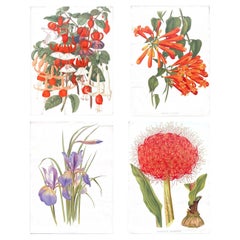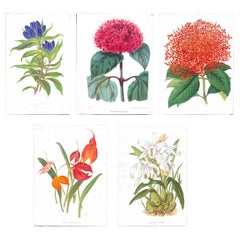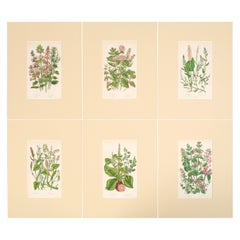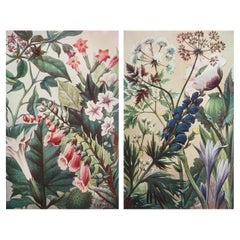Items Similar to Exquisite Botanicals: Clianthus, Grevillea, Anthurium, and More, circa 1885
Want more images or videos?
Request additional images or videos from the seller
1 of 8
Exquisite Botanicals: Clianthus, Grevillea, Anthurium, and More, circa 1885
$458.91per set
$573.64per set20% Off
£339.73per set
£424.67per set20% Off
€384per set
€480per set20% Off
CA$635.02per set
CA$793.77per set20% Off
A$699.99per set
A$874.98per set20% Off
CHF 366.27per set
CHF 457.83per set20% Off
MX$8,588.63per set
MX$10,735.79per set20% Off
NOK 4,610.57per set
NOK 5,763.22per set20% Off
SEK 4,311.62per set
SEK 5,389.52per set20% Off
DKK 2,923.77per set
DKK 3,654.72per set20% Off
About the Item
Description of the Prints with Latin and English Names
Clianthus Dampieri
English Name: Glory Pea or Dampier's Clianthus
Description: This print features striking, bright red flowers resembling lobster claws, which contrast dramatically against dark, bean-like pods and lush green foliage.
Grevillea Thelemannii splendens
English Name: Spider Net Grevillea
Description: Showcases vivid red and orange brush-like flowers, typical of the Grevillea genus, known for their unique, spidery appearance.
Anthurium Scherzerianum
English Name: Flamingo Flower
Description: Depicted with its distinctive bright red spathes and a spiraled spadix, surrounded by dark green, glossy leaves.
Erythrina Constantiana
English Name: Constantine Coral Tree
Description: Features vibrant red coral-like blooms, which are highlighted against the backdrop of large green leaves.
Cytisus Indicus
English Name: Indian Goldenthread
Description: This plant is shown with bright yellow flowers that cascade beautifully, giving it a lush, vibrant look.
Montbretias Varieties
English Name: Montbretias
Description: Displays a variety of this species in multiple colors ranging from fiery red to golden yellow, all arranged on slender, arching stems.
Makers and Publication
Artists: The prints were illustrated by various artists including "Godard," known for detailed botanical drawings.
Chromolithographer: G. Severeyns, a prominent chromolithographer, worked on transferring these illustrations onto stone for printing.
Publication: These illustrations were published in "Revue Horticole," a French horticultural review that frequently featured detailed botanical artworks. This magazine was instrumental in disseminating knowledge about various plant species to a broader audience during the 19th century.
Explanation of Chromolithography
Chromolithography is a method for making multi-color prints. This process originated in the 19th century and involves using multiple lithographic stones, one for each color, and was a revolutionary technique at the time for producing vibrant, detailed images. Each stone is meticulously prepared so that when printed in succession, they create a complete, richly colored image. This method was particularly popular for producing high-quality illustrations of botanicals, where the accuracy of the color could enhance the scientific and aesthetic value of the work. The process was both labor-intensive and required significant skill, making chromolithographs prized for their beauty and precision.
These details about the plants, their illustration process, and the historical context of their publication underline the intersection of art, science, and technology during the height of the Victorian era's interest in natural sciences.
- Dimensions:Height: 9.85 in (25 cm)Width: 6.3 in (16 cm)Depth: 0 in (0.02 mm)
- Sold As:Set of 6
- Materials and Techniques:
- Period:
- Date of Manufacture:1885
- Condition:Condition: Very good, given age. General age-related toning and/or occasional minor defects from handling. Please study scan carefully.
- Seller Location:Langweer, NL
- Reference Number:Seller: BG-13761-36, BG-13761-38, BG-13761-56, etc1stDibs: LU3054341443502
About the Seller
5.0
Recognized Seller
These prestigious sellers are industry leaders and represent the highest echelon for item quality and design.
Platinum Seller
Premium sellers with a 4.7+ rating and 24-hour response times
Established in 2009
1stDibs seller since 2017
2,613 sales on 1stDibs
Typical response time: <1 hour
- ShippingRetrieving quote...Shipping from: Langweer, Netherlands
- Return Policy
Authenticity Guarantee
In the unlikely event there’s an issue with an item’s authenticity, contact us within 1 year for a full refund. DetailsMoney-Back Guarantee
If your item is not as described, is damaged in transit, or does not arrive, contact us within 7 days for a full refund. Details24-Hour Cancellation
You have a 24-hour grace period in which to reconsider your purchase, with no questions asked.Vetted Professional Sellers
Our world-class sellers must adhere to strict standards for service and quality, maintaining the integrity of our listings.Price-Match Guarantee
If you find that a seller listed the same item for a lower price elsewhere, we’ll match it.Trusted Global Delivery
Our best-in-class carrier network provides specialized shipping options worldwide, including custom delivery.More From This Seller
View AllOriginal Vintage Botanical Illustrations from Revue Horticole, circa 1855
Located in Langweer, NL
Here are descriptions of the eight botanical illustrations, including the Latin and English names of the plants, why they are significant, and details about the creators and the tech...
Category
Antique 1850s Prints
Materials
Paper
$640 Sale Price / set
20% Off
Vibrant Botanical Lithographs: Flamingo Flower and Sturt's Desert Pea, c.1855
Located in Langweer, NL
Description of the Combined Lithographs
Left Image: Anthurium Scherzerianum
This lithograph features the Anthurium Scherzerianum, commonly known as the Flamingo Flower or Laceleaf,...
Category
Antique 1850s Prints
Materials
Paper
$114 Sale Price / set
20% Off
Exotic Blooms: A Collection of 19th-Century Chromolithographs, Published in 1875
Located in Langweer, NL
The following six chromolithographs are botanical prints from a collection illustrated by Louis Benoît Van Houtte.
Louis Benoît Van Houtte was a prominent Belgian horticulturist and...
Category
Antique 1870s Prints
Materials
Paper
$564 Sale Price / set
20% Off
1897 Antique Botanical Prints – A Red Cardinal Flower and Wilmore's Heath
Located in Langweer, NL
Title: 1897 Antique Botanical Prints – Bellflowers and Lobelias Trio
These two original 1897 botanical prints feature the cardinal flower (Lobelia cardinalis) and Wilmore's heath...
Category
Antique 1890s Prints
Materials
Paper
Lush and Vibrant: A Collection of Exotic Botanical Illustrations, circa 1875
Located in Langweer, NL
The prints depict a selection of exotic plants with a remarkable detail and vibrant color, showcasing the beauty and diversity of botanical life. Each illustration is a testament to ...
Category
Antique 1870s Prints
Materials
Paper
$391 Sale Price / set
20% Off
Botanical Illustrations from the Victorian Era: A Visual Celebration of Flora
Located in Langweer, NL
These are vibrant chromolithographs from "Favourite Flowers of Garden and Greenhouse" by Edward Step, illustrated by Désiré Bois and published in 1896 by Frederick Warne & Co., Londo...
Category
Antique 1870s English Prints
Materials
Paper
$468 Sale Price / set
20% Off
You May Also Like
Original 1880s Botanical Print of Hæmanthus Kalbreyeri — Vibrant Antique Chromol
Located in Fukuoka, JP
A striking original chromolithograph from the 1880s, this botanical print features the dramatic Hæmanthus kalbreyeri, also known as the blood lily. Characterized by its intense red s...
Category
Antique 19th Century French Prints
Materials
Paper
Bignonia venusta – Antique Botanical Chromolithograph, 1880s
Located in Fukuoka, JP
A striking original botanical print from the 1880s, featuring Bignonia venusta, also known as flame vine or orange trumpet vine. This brilliantly colored illustration captures the dr...
Category
Antique 19th Century French Prints
Materials
Paper
Set of Six English 19th Century Botanical Engravings, England, C.1880
Located in London, GB
A set of six English 19th century Botanical Engravings, England C.1880.
Mounted, ready to be framed.
Fine examples, in excellent condition commensurate of age.
Category
Antique Late 19th Century English Victorian Prints
Materials
Paper
Pair of Original Vintage Botanical Prints, circa 1900
Located in St Annes, Lancashire
Great images of medicinal plants
Unframed.
Published, circa 1900.
Free shipping
Category
Antique Early 1900s English Edwardian Prints
Materials
Paper
Collection of Early 20th Century Framed Botanic Pressed Flowers
Located in London, GB
Collection of Early 20th Century Framed Botanic Pressed Flowers
Six early 20th Century pressed botanic samples date from 1904 to 1907. Each example has a hand written paper descript...
Category
Early 20th Century European Victorian Decorative Art
Materials
Natural Fiber
Clianthus puniceus (New Zealand), Benjamin Maund botanical engraving
Located in Melbourne, Victoria
'Clianthus puniceus'
Original engraving with original hand-colouring, 1838.
Native plant of New Zealand.
From Benjamin Maund's 'The Botanist'. 1836-1...
Category
Early 19th Century Naturalistic Still-life Prints
Materials
Engraving
